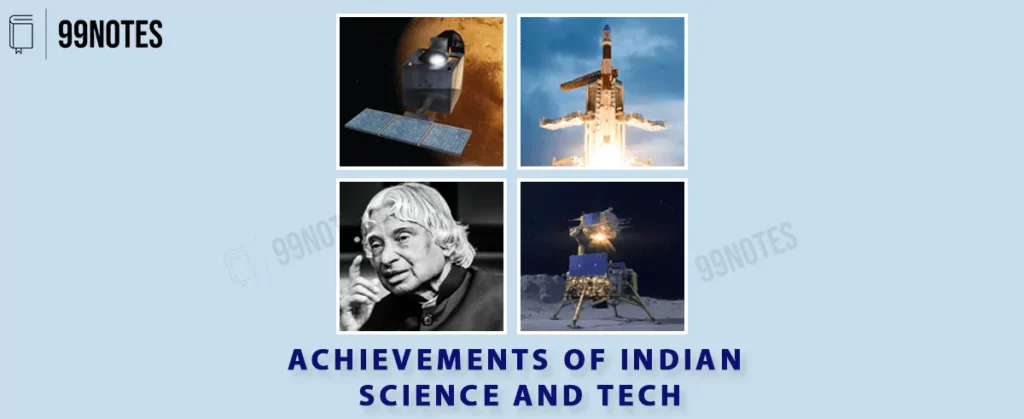
Achievement of Indian Science & Tech Free UPSC Notes Download
Achievement of Indian Science & Tech
India has made significant strides in the field of science and technology, and the following are some notable achievements:
- Space exploration: India has a successful space program, and it has launched numerous satellites for communication, meteorology, and earth observation. India has also sent a spacecraft to Mars and is planning future missions to the Moon.
- Nuclear technology: India has developed a three-stage nuclear power program, and it has several operational nuclear power plants. India is also a member of the International Atomic Energy Agency and has signed the Nuclear Non-Proliferation Treaty.
- Biotechnology: India has made significant progress in biotechnology, and it has developed various vaccines and drugs. Indian companies are also involved in research and development in areas such as agricultural biotechnology and stem cell research.
- Information technology: India is a global leader in the field of information technology, and Indian companies are involved in software development, IT services, and hardware manufacturing. India has also made significant progress in the development of electronic voting machines and biometric identification systems.
- Renewable energy: India is focusing on the development of renewable energy sources such as solar and wind power, and it has set ambitious targets for increasing the share of renewable energy in its total energy mix.
- Defense technology: India has developed its own defense technology and has a strong defense industry. It has developed various weapons systems, including missiles, aircraft, and tanks.
Since 1947, India has made the following contributions to science and technology:
Green Revolution
In 1947, India produced around 6 million tonnes of wheat, which was badly insufficient to fulfil demand, requiring the country to rely heavily on imports. Wheat output increased to 12 million in 1964 due to land reforms, improvements in irrigation infrastructure, fertiliser production, and the Intensive Agriculture District Programme, but this was still insufficient to feed all Indians. During this time, plant breeder Benjamin Peary Pal of the Indian Agriculture Research Institute was striving to improve disease resistance and production in wheat cultivars.
In 1961, IARI grew a dwarf spring wheat variety containing the Norin-10 dwarfing gene, which had been developed by Normal Borlaug in Mexico. It had a shorter stature but longer panicles. Later semi-dwarf cultivars were cultivated by farmers, providing excellent results. This led to the introduction of the Huge Yielding Varieties Programme, which includes not only wheat but also rice, maize, sorghum, and pearl millet. Under Pal, the All India Coordinated Wheat Research Project remains an exemplary instance of agricultural research. Wheat output reached 20 million tonnes in 1970, while rice production reached 42 million tonnes. Thus started the Green Revolution, which enabled India to become self-sufficient in foodgrain production within a few decades.
White Revolution
At the time of independence, India imported not just foodgrains but also milk products such as infant formula, butter, and cheese. In 1955, India imported 500 tonnes of butter and 3000 tonnes of infant formula from European dairy firms. Tribhuvandas Patel founded the Kaira District Cooperative Milk Producers Union Limited in 1946, which marked the beginning of the dairy movement.
Verghese Kurien arrived in Anand in 1949 to fulfil the terms of the bond he signed with the government before to receiving a government scholarship to study in the United States. In 1950, he remained and was promoted to General Manager of the cooperative. The variable milk output was a dilemma for the dairy, since extra milk found no buyers. European dairy industries were unwilling to give up milk powder technology and believed that buffalo milk could not be transformed into powder.
H M Dalaya, a young dairy engineer who worked for Kurien in Anand and established via tests that buffalo milk can be transformed to milk powder. For the first time in history, Dalaya created an apparatus utilising a spray paint gun and an air heater to produce powder from buffalo milk.
Later, he demonstrated that a commercially available device, Niro Atomizer, could do the same function. This paved the way for a dairy revolution in India and the establishment of a national milk grid, allowing the country to become self-sufficient.
Satellite and communication revolution
In the mid-1960s, when Vikram Sarabhai, as chairman of the Indian National Committee for Space Research, envisioned the use of satellite technology for communication, remote sensing, and weather forecasting, few people believed him since India lacked the ability to construct rockets or satellites. He desired that India utilise space technology for education, health care, and rural development.
With the success of the Satellite Instructional Television Experiment (SITE) and the Soviet launch of the Aryabhata satellite, India not only acquired such a capacity but also proved to the world the peaceful application of space technology within a decade.
In a subsequent decade, Indian scientists launched the groundbreaking INSAT and IRS series of satellites, offering communication and television services to millions of people across the nation. Using satellites built in India, meteorological phenomena such as cyclones may be accurately forecasted in time to save lives. Through pioneering use of the VSAT (Very Small Aperture Terminal) technology, banking and other services were transformed in the 1980s.
Pharmaceutical and vaccine production
Today, India is recognised as the “pharmacy of the world” since Indian enterprises provide inexpensive pharmaceuticals and vaccinations to both poor and developed nations. It has been a long road from the period when Indian drug sector was dominated by foreign firms whose products were excessively priced.
The federal government formed Hindustan Antibiotics Limited in 1954 and the Indian Drugs and Pharmaceuticals Limited (IDPL) with Soviet aid in order to break the monopoly of international firms. These public sector units – along with national laboratories like National Chemicals Laboratory (NCL), Regional Research Laboratory Hyderabad (now known as Indian Institute of Chemical Technology) and Central Drug Research Institute – played a central role in generating necessary knowledge base and human resources needed for Indian industry to grow.
The 1970 Patent Act recognised only process patents, allowing Indian firms to produce replicas of patented medications using other procedures. CSIR laboratories created procedures for a variety of pharmaceuticals, including ciprofloxacin, diclofenac, salbutamol, omeprazole, and azithromycin, and licenced the technology to private firms. Over the next two decades, these factors contributed to the growth of indigenous R&D and manufacturing capacities.
C-DOT and communications revolution
Similar to most other industries, the telecom industry was dependent on supply from global businesses, and new technology could not enter the market owing to exorbitant costs and a lack of foreign currency. The switching technology was deemed crucial, and only a few businesses owned it. In the 1970s, the waiting period for a telephone connection in India was many years, and rural connectivity is exceedingly inadequate.
The initial attempt to construct an indigenous electronic exchange was launched in the 1960s at the Telecom Research Centre (TRC), and the first achievement was the development of a 100-line electronic switch in 1973. Scientists from the Tata Institute of Fundamental Research (TIFR) and IIT Bombay created a digital Automatic Electronic Switch for the army about the same time. In 1984, the government founded the Centre for the Development of Telematics (C-DOT) by combining scientific teams from TRC and TIFR under Sam Pitroda’s supervision.
Indians created a telephone exchange that could function in extreme environments and without air conditioning. Free technology transfer from the public sector to the private sector ended the monopoly of multinational corporations and swiftly brought connection to rural regions. C-DOT exchange gained popularity in a large number of developing countries.
IT revolution and computerisation of railways
During the decades after India’s independence, IBM and ICL dominated the data processing business in the country. These two companies’ data processing equipment were utilised by the government, public sector, military forces, and research organisations.
These businesses transported obsolete and abandoned machinery to India and rented them at exorbitant rates. India need modern computers for National Sample Surveys, nuclear reactor construction, and other research uses. 1970 saw the establishment of the Department of Electronics in an effort to break the monopoly of large corporations and stimulate domestic software and hardware development.
The establishment of public sector firms such as Electronics Corporation of India Limited (ECIL), Computer Maintenance Corporation (CMC), and state electronic development organisations. The acquired skills and expertise were then transferred to the commercial sector.
The passenger reservation project of the Railways, established in 1986, was the first major application of information technology. It was the largest experiment of its kind to illustrate how technology can enhance efficiency, reduce corruption, and impact the lives of millions without requiring people to own a digital device.
Blue Revolution
The ‘blue revolution’ refers to the implementation of a series of initiatives to increase the production of fish and other marine goods. It was officially inaugurated in 1970 when the Fish Farmers’ Development Agency was established as part of the Fifth Five-Year Plan. Later, similar development organisations for brackish water development were established to promote aquaculture in a number of states.
The purpose of all of this was to introduce new procedures for fish breeding, rearing, and marketing, as well as to commence production of other marine goods like as shrimp, oysters, seaweeds, pearls, etc., utilising new scientific inputs. Numerous innovative technologies created by research institutes affiliated with the Indian Council of Agriculture Research (ICAR) have been transmitted to fish farmers across the nation.

